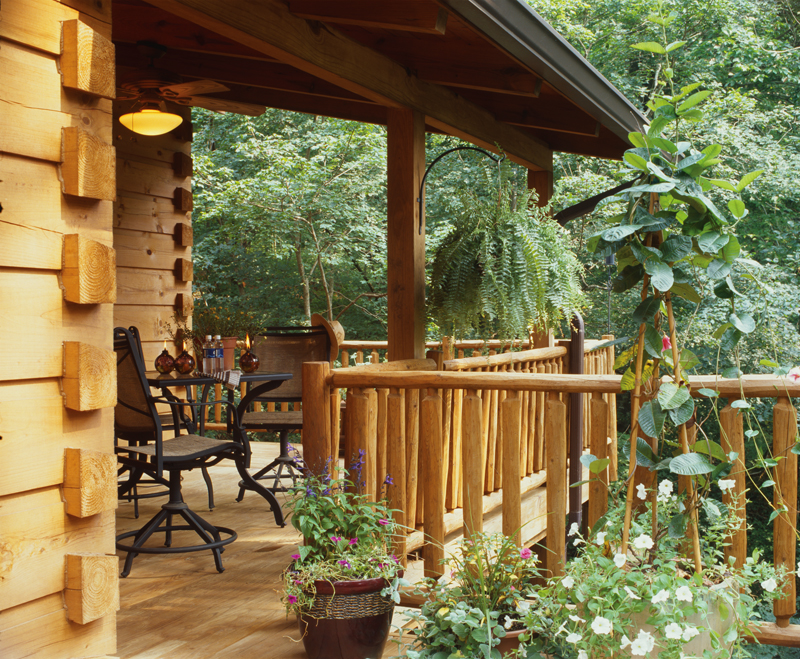We all dream of living in a log home. But what we don’t dream about is spending countless hours maintaining that home. The good news is that if you build it right in the first place, maintenance won’t be an issue. To help with that effort, we spoke to several experts about what it takes to design a log home for minimal exterior maintenance. Here’s what they had to say.
1. Examine the Overhangs
Most wood rot and damage comes from water splashing onto the logs. If your roof overhangs adequately in all the right places, though, this won’t be a problem. “I recommend a minimum of two feet of overhang on the eaves, and perhaps more on the gables depending upon the specific design of the home,” says Mark Feder, vice president of sales for Appalachian Log Structures in Ripley, West Virginia. “For instance, as much as a five-foot overhang is appropriate on the gable if there is a door located on that side of the home.”
2. Put in a Porch
One of the best ways to protect your logs from rain and other weather damage is with a porch, says John Ricketson, project manager for Hearthstone, Inc., in Macon, Georgia. That’s why John recommends incorporating porches into the log home design wherever it’s appropriate. “In my experience, porches reduce maintenance by 90 percent or more,” he says.
3. Keep Logs off the Ground
Splash-back onto logs from the surrounding dirt and mud is also a major cause of damage, but this can be eliminated simply by keeping the lowest course of logs well up off the ground. In fact, our experts recommend starting that first course of logs at least two feet above the grade. “Use durable materials such as stone close to the ground to keep standing snow and ice off logs, timbers, and siding,” says Matthew Franklin, lead architect for Mountain Architects in Boise, Idaho.
4. Choose the Right Logs
These days, it’s not so much the wood you choose as how it’s prepared for the home that makes a difference in maintenance. “We strongly recommend the use of borate pressure-treated logs for maximum durability,” says Feder. “Relying strictly on the use of decay- and insect-resistant wood species may not eliminate future problems.”
5. Find a Functional Finish
The other way to make your logs last is with the right finish. And the best way to minimize maintenance, says Ricketson, is to use both a stain and a clear top coat. “Just like your car, where the clear top coat protects the paint, we use a clear top coat to protect the stain,” he says. “This allows the stain to have more UV inhibitors and fungicides and less water repellants for easier application of multiple coats.” Ricketson adds that you’ll still need to reapply the top coat every few years, but the stain should remain well-preserved this way, which is a pretty good trade-off.
6. Focus on Windows & Doors
For a log home, the first choice would seem to be wood for windows and doors, but our experts disagree. “We would strongly recommend a clad unit such as aluminum or vinyl,” says Feder. “Experience has shown us that homeowners generally do a poor job of maintaining an all-wood exterior door or window.”
7. Roof It Right
If you can afford it, an all-metal roof is the ultimate in low-maintenance durability, says Franklin. But shingles can also be extremely reliable at a more reasonable price. “Architectural composition asphalt shingles offer an excellent lower cost alternative,” he says. “There are great-looking options out there now, and many come with 30-year or even 50-year warranties.”
8. Plan for Plants
Trees and plants are an important part of any home’s landscape, but where you put them can impact maintenance. “When planting new trees, plan for future growth,” says Feder. “Plant close enough to provide an adequate wind break and shade, but not too close to trap moisture against the home and create potential mold and mildew problems or cause roots to grow too close to the foundation walls or septic systems.”
Also, be careful with smaller plants and shrubbery that you put in the immediate vicinity of the home, says Ricketson. “Keep the foliage of landscaping plants away from the house by at least two feet by planting three to four feet away and doing regular trimming,” he says. “This reduces insect safe havens and reduces moisture on the walls.”

